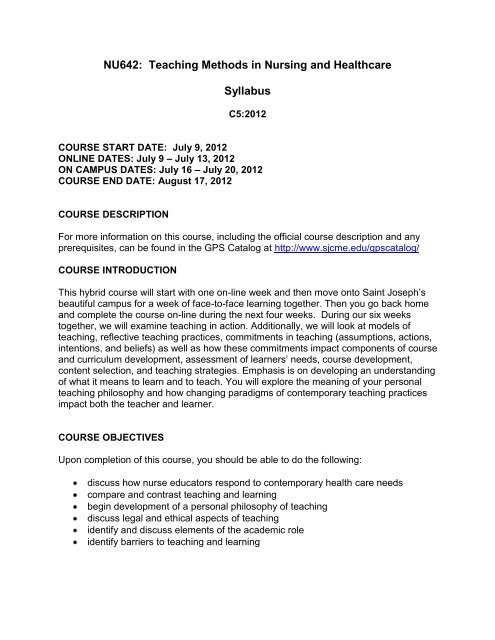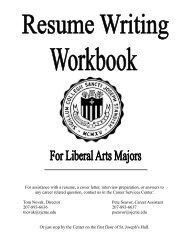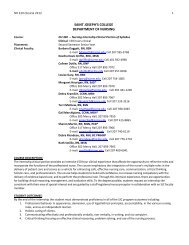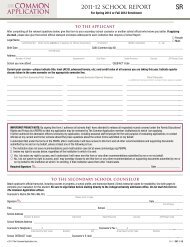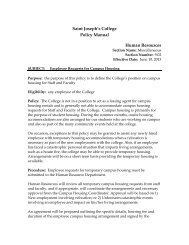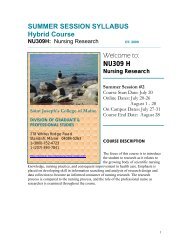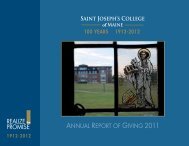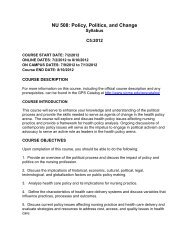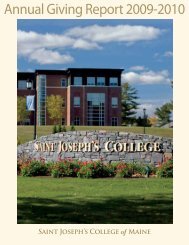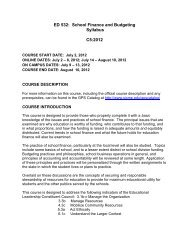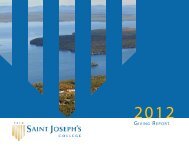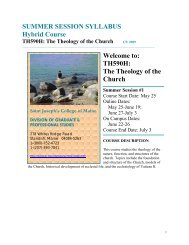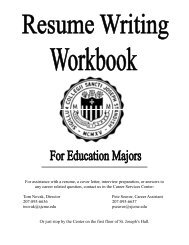NU642: Teaching Methods in Nursing and Healthcare Syllabus
NU642: Teaching Methods in Nursing and Healthcare Syllabus
NU642: Teaching Methods in Nursing and Healthcare Syllabus
Create successful ePaper yourself
Turn your PDF publications into a flip-book with our unique Google optimized e-Paper software.
<strong>NU642</strong>: <strong>Teach<strong>in</strong>g</strong> <strong>Methods</strong> <strong>in</strong> Nurs<strong>in</strong>g <strong>and</strong> <strong>Healthcare</strong><br />
<strong>Syllabus</strong><br />
C5:2012<br />
COURSE START DATE: July 9, 2012<br />
ONLINE DATES: July 9 – July 13, 2012<br />
ON CAMPUS DATES: July 16 – July 20, 2012<br />
COURSE END DATE: August 17, 2012<br />
COURSE DESCRIPTION<br />
For more <strong>in</strong>formation on this course, <strong>in</strong>clud<strong>in</strong>g the official course description <strong>and</strong> any<br />
prerequisites, can be found <strong>in</strong> the GPS Catalog at http://www.sjcme.edu/gpscatalog/<br />
COURSE INTRODUCTION<br />
This hybrid course will start with one on-l<strong>in</strong>e week <strong>and</strong> then move onto Sa<strong>in</strong>t Joseph’s<br />
beautiful campus for a week of face-to-face learn<strong>in</strong>g together. Then you go back home<br />
<strong>and</strong> complete the course on-l<strong>in</strong>e dur<strong>in</strong>g the next four weeks. Dur<strong>in</strong>g our six weeks<br />
together, we will exam<strong>in</strong>e teach<strong>in</strong>g <strong>in</strong> action. Additionally, we will look at models of<br />
teach<strong>in</strong>g, reflective teach<strong>in</strong>g practices, commitments <strong>in</strong> teach<strong>in</strong>g (assumptions, actions,<br />
<strong>in</strong>tentions, <strong>and</strong> beliefs) as well as how these commitments impact components of course<br />
<strong>and</strong> curriculum development, assessment of learners’ needs, course development,<br />
content selection, <strong>and</strong> teach<strong>in</strong>g strategies. Emphasis is on develop<strong>in</strong>g an underst<strong>and</strong><strong>in</strong>g<br />
of what it means to learn <strong>and</strong> to teach. You will explore the mean<strong>in</strong>g of your personal<br />
teach<strong>in</strong>g philosophy <strong>and</strong> how chang<strong>in</strong>g paradigms of contemporary teach<strong>in</strong>g practices<br />
impact both the teacher <strong>and</strong> learner.<br />
COURSE OBJECTIVES<br />
Upon completion of this course, you should be able to do the follow<strong>in</strong>g:<br />
discuss how nurse educators respond to contemporary health care needs<br />
compare <strong>and</strong> contrast teach<strong>in</strong>g <strong>and</strong> learn<strong>in</strong>g<br />
beg<strong>in</strong> development of a personal philosophy of teach<strong>in</strong>g<br />
discuss legal <strong>and</strong> ethical aspects of teach<strong>in</strong>g<br />
identify <strong>and</strong> discuss elements of the academic role<br />
identify barriers to teach<strong>in</strong>g <strong>and</strong> learn<strong>in</strong>g
COURSE FORMAT<br />
This is blended or hybrid course consist<strong>in</strong>g of 5 weeks of onl<strong>in</strong>e work <strong>and</strong> a week of<br />
face-to-face time <strong>in</strong> the classroom. You will be provided an opportunity to dialogue<br />
about various topics <strong>and</strong> issues with<strong>in</strong> nurs<strong>in</strong>g education throughout our time together.<br />
You will acquire the skills outl<strong>in</strong>ed <strong>in</strong> the course objectives through the follow<strong>in</strong>g:<br />
Read<strong>in</strong>gs from the textbooks, required read<strong>in</strong>gs <strong>and</strong> various websites.<br />
Instructor notes<br />
Active discussion <strong>and</strong> ongo<strong>in</strong>g dialogue among your <strong>in</strong>structor <strong>and</strong> fellow learners<br />
via the course bullet<strong>in</strong> board <strong>and</strong> face-to-face <strong>in</strong> the classroom<br />
Informal <strong>and</strong> formal writ<strong>in</strong>g submitted via bullet<strong>in</strong> board<br />
Classroom experiences will have you engaged <strong>in</strong> both teach<strong>in</strong>g <strong>and</strong> learn<strong>in</strong>g<br />
activities<br />
Reflective summary of your learn<strong>in</strong>g at the end of the course<br />
COURSE GUIDELINES<br />
I have <strong>in</strong>cluded a rather detailed course outl<strong>in</strong>e that we will guide our time together over<br />
the next few weeks. While we will be meet<strong>in</strong>g face-to-face for a week, there is much to<br />
do on-l<strong>in</strong>e prior to our meet<strong>in</strong>g <strong>and</strong> of course follow<strong>in</strong>g our face-to-face week together. I<br />
have set up a number of discussion forums to help facilitate our conversations. Please<br />
start with the gett<strong>in</strong>g acqua<strong>in</strong>ted forum <strong>and</strong> share with the group a little bit about<br />
yourself, your <strong>in</strong>terest <strong>in</strong> this course, <strong>and</strong> an experience that st<strong>and</strong>s out <strong>in</strong> your memory<br />
regard<strong>in</strong>g your learn<strong>in</strong>g as a student (this could be viewed as successful or<br />
challeng<strong>in</strong>g). What st<strong>and</strong>s out <strong>in</strong> your memory regard<strong>in</strong>g the teach<strong>in</strong>g <strong>and</strong> learn<strong>in</strong>g that<br />
occurred with<strong>in</strong> this story After read<strong>in</strong>g one another’s stories about learn<strong>in</strong>g, what<br />
st<strong>and</strong>s out as similarities <strong>in</strong> the stories Differences Why might this be so Are there<br />
any summations or generalizations that you can draw regard<strong>in</strong>g how teach<strong>in</strong>g <strong>and</strong><br />
learn<strong>in</strong>g have been viewed through the experiences of those <strong>in</strong> this course Please post<br />
your thoughts to the discussion forum.<br />
Please have posted your <strong>in</strong>itial <strong>in</strong>formation by Monday, 9 July at 6 pm. Please respond<br />
to peer post<strong>in</strong>gs by Friday 13 July at 6 pm.<br />
Because of the asynchronistic nature of on-l<strong>in</strong>e courses you will need to post a<br />
m<strong>in</strong>imum of three times per week, once for your check-<strong>in</strong>, once for the new material <strong>in</strong><br />
the write <strong>and</strong> post section of the course outl<strong>in</strong>e, <strong>and</strong> at least once <strong>in</strong> response to others’<br />
work from earlier <strong>in</strong> the week.<br />
Some thoughts regard<strong>in</strong>g on-l<strong>in</strong>e discussions:<br />
Take advantage of the opportunity to use ‘threaded discussions’ on ANGEL. This<br />
will help you organize where to post your ideas <strong>and</strong> your responses to post<strong>in</strong>gs.<br />
Be specific about why you found another person’s ideas useful or <strong>in</strong>terest<strong>in</strong>g.<br />
Disagree with someone <strong>in</strong> a respectful <strong>and</strong> considerate why.
If you don’t underst<strong>and</strong> someone’s viewpo<strong>in</strong>t, ask a cause-<strong>and</strong> –effect question—<br />
for example: “Can you expla<strong>in</strong> why you th<strong>in</strong>k it’s true that if these th<strong>in</strong>gs are <strong>in</strong><br />
place, such <strong>and</strong> such will occur”<br />
Because the subject matter <strong>in</strong> the read<strong>in</strong>gs may be complex, <strong>and</strong> values-related<br />
comments from your onl<strong>in</strong>e classmates may br<strong>in</strong>g out strong reactions from you,<br />
give yourself some time to consider their po<strong>in</strong>ts of view before respond<strong>in</strong>g.<br />
Because we are not talk<strong>in</strong>g face-to-face, <strong>in</strong>teractions <strong>and</strong> all of the non-verbal<br />
cues we experience <strong>in</strong> these conversations are lost on-l<strong>in</strong>e, please try to f<strong>in</strong>d<br />
ways to express appreciation for what you may have learned from the<br />
discussions.<br />
Remember, there is no one correct perspective on or answer to the read<strong>in</strong>gs <strong>and</strong><br />
assignments we discuss as a group. If your views differ from others, try to th<strong>in</strong>k about<br />
why this maybe so <strong>and</strong> ask questions to further your underst<strong>and</strong><strong>in</strong>g.<br />
PLEASE consider issues of confidentiality when post<strong>in</strong>g <strong>and</strong> remove any identify<strong>in</strong>g<br />
<strong>in</strong>formation <strong>in</strong> your post<strong>in</strong>gs, this would <strong>in</strong>clude modify<strong>in</strong>g biographical details of<br />
<strong>in</strong>dividuals <strong>and</strong> or communities to mask their identities, not shar<strong>in</strong>g details that would<br />
identify people, places, situations. Talk about the bigger issues <strong>and</strong> supply only enough<br />
<strong>in</strong>formation to help us make sense of the story. All discussions, that take place as part<br />
of this course, are to be kept confidential <strong>and</strong> not discussed outside of the course. You<br />
are encouraged to talk about your experiences <strong>and</strong> share your stories, however, please<br />
do not share others’ stories or on-l<strong>in</strong>e comments outside of our group.<br />
On a weekly basis I would like for each of us to check-<strong>in</strong>. If we were <strong>in</strong> a traditional<br />
classroom we would start the beg<strong>in</strong>n<strong>in</strong>g of each class with a brief check-<strong>in</strong>. There will be<br />
a discussion forum for this on Angel. This check-<strong>in</strong> is modeled after Ch<strong>in</strong>n’s (2007)<br />
check-<strong>in</strong> process that she describes <strong>in</strong> Peace & Power. This is not expected to be<br />
lengthy, just a means of lett<strong>in</strong>g us know how you are, if there are extenuat<strong>in</strong>g<br />
circumstances that have you be<strong>in</strong>g less than fully present <strong>in</strong> our discussions or if<br />
someth<strong>in</strong>g wonderful has happened that you would like to share with the group. This is<br />
not meant to be repetitive from the discussions each week regard<strong>in</strong>g the topic/read<strong>in</strong>gs/<br />
assignments. You might f<strong>in</strong>d that you have had an <strong>in</strong>sight, a reflection, a general<br />
observation that you would like to share with the group, this would be the place to do<br />
that. Dur<strong>in</strong>g the week that we are together we will check <strong>in</strong> at the beg<strong>in</strong>n<strong>in</strong>g of each<br />
class <strong>and</strong> check out at the end of our time together.<br />
I have <strong>in</strong>cluded 5 head<strong>in</strong>gs to help “sort” through the weekly work of this course<br />
Read<br />
Journal<br />
Write <strong>and</strong> post<br />
Conversations on discussion board<br />
Reflective summary
Read<br />
This is what needs to be read, looked at, or done before you beg<strong>in</strong> your discussion on<br />
the bullet<strong>in</strong> board or our class meet<strong>in</strong>g dur<strong>in</strong>g the week we are together. This might<br />
<strong>in</strong>clude required read<strong>in</strong>gs, look<strong>in</strong>g at video or webpage, or some other activity.<br />
Journal<strong>in</strong>g<br />
It is important to recognize that you will be asked to journal about different ideas <strong>and</strong><br />
topics on a regular basis. As journal writ<strong>in</strong>g, these are your thoughts <strong>and</strong> responses to<br />
the material be<strong>in</strong>g presented. You are not expected to share this with the group. You<br />
may f<strong>in</strong>d that some of your journal<strong>in</strong>g is someth<strong>in</strong>g that you would like to share with<strong>in</strong><br />
the conversation with classmates on the bullet<strong>in</strong> board or face-to-face <strong>and</strong> this is f<strong>in</strong>e.<br />
By journal<strong>in</strong>g you will beg<strong>in</strong> to engage with reflective practice <strong>and</strong> this <strong>in</strong>formation will be<br />
useful to you as you work through the course. You might also use your journal to keep<br />
track of new terms <strong>and</strong> ideas that are expressed with<strong>in</strong> the read<strong>in</strong>gs or <strong>in</strong> conversation<br />
with one another.<br />
Write <strong>and</strong> post<br />
This is the stuff that you need to post to the discussion board <strong>and</strong> will primarily be your<br />
responses to questions asked each week.<br />
Conversation<br />
This is where you respond to what others have written <strong>and</strong> posted on the discussion<br />
board for the week’s focus. This might <strong>in</strong>clude questions, comments, observations,<br />
thoughts, bra<strong>in</strong>storms, attachments, <strong>and</strong> so forth. Sometimes I’ll ask that you make<br />
observations or summarize what is be<strong>in</strong>g said but mostly this is where you talk with one<br />
another about the th<strong>in</strong>gs you are th<strong>in</strong>k<strong>in</strong>g about <strong>and</strong> ponder<strong>in</strong>g.<br />
Reflective summary<br />
This will be a section that will ask you to th<strong>in</strong>k about the topics be<strong>in</strong>g discussed <strong>and</strong><br />
reflect on what has been said <strong>and</strong> what mean<strong>in</strong>g you are mak<strong>in</strong>g of it all. This can be<br />
done <strong>in</strong> many ways, you might add your thoughts to the conversation, you might journal,<br />
or you might th<strong>in</strong>k about what you’ve been read<strong>in</strong>g, convers<strong>in</strong>g about, <strong>and</strong> spend some<br />
dedicated time go<strong>in</strong>g over all of this <strong>in</strong> your m<strong>in</strong>d. The idea here is to practice be<strong>in</strong>g a<br />
reflective practitioner <strong>and</strong> the only way to do this is to do this.<br />
IF YOU HAVE ANY QUESTIONS ABOUT WHAT HAS JUST BEEN EXPLAINED<br />
PLEASE, PLEASE GO TO THE BULLETIN BOARD AND ASK YOUR QUESTIONS.<br />
THERE WILL BE A DESIGNATED FORUM FOR GETTING ACQUAINTED AND FIRST<br />
DAY QUESTIONS.
REQUIRED TEXT(s)<br />
Benner, P., Sutphen, M., Leonard, V., Day, L. (2010). Educat<strong>in</strong>g nurses: A call for<br />
radical transformation (Carnegie Foundation for the advancement of teach<strong>in</strong>g).<br />
San Francisco, Jossey-Bass. 9789479457962<br />
Herman, J. W. (2008). Creative teach<strong>in</strong>g strategies for the nurse educator. Philadelphia:<br />
F. A. Davis. 9780803614321<br />
Palmer, P. (2007). The courage to teach. San Francisco, CA: Jossey-Bass. ISBN<br />
9780787996864<br />
Pratt, D. (1998). Five perspectives on teach<strong>in</strong>g <strong>in</strong> adult <strong>and</strong> higher education. Malabar,<br />
FL, Krieger. 9780894649370<br />
Young, L. E. & Paterson, B. L. (2007). <strong>Teach<strong>in</strong>g</strong> nurs<strong>in</strong>g: Develop<strong>in</strong>g a student-centered<br />
learn<strong>in</strong>g environment. Philadelphia: Lipp<strong>in</strong>cott Williams & Wilk<strong>in</strong>s. 780781757729<br />
Highly recommended textbook:<br />
Hills, M. & Watson, J. (2011). Creat<strong>in</strong>g a science curriculum: An emancipatory<br />
pedagogy for nurs<strong>in</strong>g. New York: Spr<strong>in</strong>ger 9780826105899<br />
If you have any questions regard<strong>in</strong>g your course materials, please<br />
contact your academic advisor <strong>and</strong>/or our book vendor EdMap. You can<br />
reach EdMap by phone 1- (800)-274-9104 or website at<br />
http://www.edmapbookstore.com/storefront/<strong>in</strong>dex/STJSP<br />
REQUIRED ARTICLES<br />
In addition to the required books you have purchased for this course, I have compiled a<br />
bibliography that you will likely f<strong>in</strong>d <strong>in</strong>terest<strong>in</strong>g <strong>and</strong> helpful <strong>in</strong> your successful completion<br />
of this course. You will f<strong>in</strong>d these articles <strong>and</strong> book chapters on ANGEL. Many, but not<br />
all of those listed, have been assigned as read<strong>in</strong>gs for different units. This has been<br />
posted to ANGEL as a separate document.<br />
REQUIRED INTERNET SITES & INTERNET RESOURCES<br />
There are required Internet sites <strong>and</strong> resources that you are asked to look at throughout<br />
the course. These can be found with<strong>in</strong> each of the units beg<strong>in</strong>n<strong>in</strong>g with Unit 2. There<br />
will be other sites that you will be encouraged to visit throughout the course. These will<br />
be posted <strong>in</strong> the discussions or separately on ANGEL<br />
WRITTEN ASSIGNMENTS<br />
In your papers you are asked to meet the follow<strong>in</strong>g criteria:
Critical Th<strong>in</strong>k<strong>in</strong>g<br />
Lay out argument clearly <strong>and</strong> thoughtfully<br />
Demonstrate orig<strong>in</strong>al th<strong>in</strong>k<strong>in</strong>g <strong>and</strong> synthesis of ideas<br />
Clearly l<strong>in</strong>k support<strong>in</strong>g sources <strong>and</strong> your own argument<br />
Use course concepts/materials to develop ideas<br />
Demonstrate depth <strong>and</strong> clarity of reason<strong>in</strong>g<br />
Presentation <strong>and</strong> Formatt<strong>in</strong>g<br />
Use correct grammar, punctuation, spell<strong>in</strong>g, <strong>and</strong> sentence structure<br />
Use clear <strong>and</strong> succ<strong>in</strong>ct writ<strong>in</strong>g style<br />
Organize content to demonstrate logical flow of ideas<br />
Use APA 6 th edition for formatt<strong>in</strong>g (e.g., font, marg<strong>in</strong>s, title page, et), text<br />
citation <strong>and</strong> reference lists.<br />
ASSIGNMENTS<br />
Participation Assignment<br />
The participation assignment is based on your own ideas about how <strong>and</strong> what<br />
you personally contributed <strong>and</strong> learned from this course. It will be helpful for you to keep<br />
a journal of your thoughts over the 6 weeks you are enrolled <strong>in</strong> this course. I would<br />
encourage you to keep track of your thoughts, reactions, underst<strong>and</strong><strong>in</strong>gs of the<br />
read<strong>in</strong>gs, <strong>and</strong> your questions. You can use this <strong>in</strong>formation to reflect on the quality of<br />
your achievements over time <strong>in</strong> terms of the follow<strong>in</strong>g questions:<br />
Has my work been consistent with the course objectives<br />
Did I accomplish my personal goals for the course<br />
Is my written work scholarly, concise, clearly written, <strong>and</strong> have I accurately<br />
credited other authors where I have drawn on their work<br />
Have my written <strong>and</strong> verbal presentations <strong>in</strong>cluded my own orig<strong>in</strong>al ideas as well<br />
as those I have found <strong>in</strong> the literature<br />
Have I frequently considered more than one po<strong>in</strong>t of view<br />
Have I thought about <strong>and</strong> presented possibilities for future directions <strong>in</strong> nurs<strong>in</strong>g<br />
education<br />
Have I assisted others <strong>in</strong> the exploration of the concepts of teach<strong>in</strong>g <strong>and</strong> learn<strong>in</strong>g<br />
<strong>in</strong> creative <strong>and</strong> mean<strong>in</strong>gful ways<br />
Generally, if you can answer ‘yes’ to each of these questions, you have met the<br />
essential expectations of the course <strong>and</strong> certa<strong>in</strong>ly have earned a grade of ‘B’. If your<br />
answers are an enthusiastic ‘YES’ <strong>and</strong> you are able to provide clear examples of<br />
how you were to exercise creativity <strong>and</strong> accomplishments beyond your expectations,<br />
be confident <strong>and</strong> proud to claim that you have earned an ‘A’ grade.<br />
These questions will also be considered by the <strong>in</strong>structor <strong>in</strong> verify<strong>in</strong>g your<br />
statement of the grade earned through your achievements <strong>and</strong> documentation. If the<br />
<strong>in</strong>structor has reservations about your self-evaluation, the concerns will be<br />
discussed with you until we both agree on the grade that you have earned.
<strong>Teach<strong>in</strong>g</strong>/Learn<strong>in</strong>g Observation Experience Assignment<br />
Read Pratt’s book specifically explor<strong>in</strong>g the 5 different teach<strong>in</strong>g patterns he outl<strong>in</strong>es<br />
with<strong>in</strong> the text.<br />
Attend two different teach<strong>in</strong>g/learn<strong>in</strong>g experiences of your choos<strong>in</strong>g. I would like for<br />
you to have them <strong>in</strong> nurs<strong>in</strong>g (a class, an <strong>in</strong>-service, a conference, etc.) but given the<br />
time frame of this course <strong>and</strong> limited time to prepare for it, this may not be possible. You<br />
will not have po<strong>in</strong>ts deducted if the ‘teach<strong>in</strong>g’ is outside of nurs<strong>in</strong>g. Turn <strong>in</strong> a written<br />
assignment that identifies the patterns of teach<strong>in</strong>g you observed <strong>and</strong> examples of how<br />
you have come to these conclusions. Discuss the purpose <strong>and</strong> rationale of what you<br />
observed <strong>and</strong> explore the various possible outcomes to students <strong>and</strong> teacher based on<br />
these observations, analysis <strong>and</strong> evaluation. This paper is likely to be between 4-6<br />
pages.<br />
Philosophy of Nurs<strong>in</strong>g Education--F<strong>in</strong>al Paper<br />
The f<strong>in</strong>al paper of this course provides the learner with the opportunity to articulate a<br />
deepen<strong>in</strong>g underst<strong>and</strong><strong>in</strong>g of their philosophy of nurs<strong>in</strong>g education along with key<br />
concepts concern<strong>in</strong>g teach<strong>in</strong>g, learn<strong>in</strong>g, <strong>and</strong> curriculum development. Among the<br />
questions to consider <strong>in</strong> this f<strong>in</strong>al paper are: What frameworks are available to help<br />
guide your th<strong>in</strong>k<strong>in</strong>g <strong>and</strong> practice <strong>in</strong> teach<strong>in</strong>g What are the values <strong>and</strong> beliefs that relate<br />
to different perspectives or approaches to teach<strong>in</strong>g How do your beliefs about the<br />
purposes of nurs<strong>in</strong>g education <strong>and</strong> higher education <strong>in</strong>fluence what knowledge is<br />
<strong>in</strong>cluded or excluded <strong>in</strong> your philosophy, practice of nurs<strong>in</strong>g education, <strong>and</strong> curriculum<br />
development What have been the assumptions that have led to differ<strong>in</strong>g viewpo<strong>in</strong>ts<br />
about what should be <strong>in</strong>cluded <strong>in</strong> a curriculum <strong>and</strong> how teach<strong>in</strong>g should occur What<br />
are useful approaches for you <strong>in</strong> consider<strong>in</strong>g your philosophy of nurs<strong>in</strong>g education <strong>and</strong><br />
becom<strong>in</strong>g a nurse educator What do you see as the challeng<strong>in</strong>g issues about<br />
academic programs <strong>and</strong> <strong>in</strong>struction confront<strong>in</strong>g nurse educators today<br />
Revisit your journals entries, course read<strong>in</strong>gs, <strong>and</strong> the discussion board forums for<br />
additional examples of various approaches of how a philosophy plays out <strong>in</strong> practice.<br />
This paper will likely be around 10 pages.<br />
Learn<strong>in</strong>g Activity Assignment (small group work)<br />
Lead the group <strong>in</strong> a discussion regard<strong>in</strong>g a topic with<strong>in</strong> nurs<strong>in</strong>g education that you are<br />
<strong>in</strong>terested <strong>in</strong> learn<strong>in</strong>g more about. This discussion should <strong>in</strong>clude a purpose/focus<br />
statement for the discussion, a list of read<strong>in</strong>gs, an assignment, an <strong>in</strong> class learn<strong>in</strong>g<br />
activity, 3 <strong>in</strong> class discussion questions, 3 onl<strong>in</strong>e discussion questions <strong>and</strong> a method by<br />
which you will evaluate the effectiveness of the learn<strong>in</strong>g activity you have developed.<br />
Th<strong>in</strong>gs you might consider look<strong>in</strong>g at:<br />
Develop a cl<strong>in</strong>ical assignment that has the learner explor<strong>in</strong>g their cl<strong>in</strong>ical<br />
judgment <strong>and</strong> reason<strong>in</strong>g. Identify ways that you have used ideas discussed by<br />
Tanner or Ironside.
Discuss key components you would want to see <strong>in</strong>cluded <strong>in</strong> an evaluation tool<br />
that you might use <strong>in</strong> teach<strong>in</strong>g cl<strong>in</strong>ical.<br />
How might hook’s work <strong>Teach<strong>in</strong>g</strong> to Transgress <strong>in</strong>form the practice of nurs<strong>in</strong>g<br />
education<br />
The possibilities are endless. Please be sure <strong>and</strong> discuss your <strong>in</strong>itial ideas with the<br />
<strong>in</strong>structor so that you know you are headed <strong>in</strong> a successful direction. You will be<br />
present<strong>in</strong>g this <strong>in</strong>formation the last two days of class. The schedule <strong>and</strong> small group<br />
cluster will be developed dur<strong>in</strong>g the first part of our week together.
CLASS SCHEDULE (See detail for units, read<strong>in</strong>gs & assignments directly<br />
follow<strong>in</strong>g this schedule)<br />
Week 1 - Onl<strong>in</strong>e<br />
Topic:<br />
On l<strong>in</strong>e welcome, orientation, gett<strong>in</strong>g acqua<strong>in</strong>ted:<br />
Assignments:<br />
Unit 1<br />
Discussion questions<br />
Week 2 – Day 1 On-campus<br />
Topic:<br />
Introductions<br />
<strong>Teach<strong>in</strong>g</strong> site discussion<br />
Musical chairs activity<br />
Draw<strong>in</strong>g activity<br />
Assignments:<br />
Review Unit 1<br />
Class discussion<br />
Onl<strong>in</strong>e-discussion forum<br />
Classroom activities<br />
Week 2 – Day 2 On-campus<br />
Topic:<br />
Unit 2<br />
Class discussion<br />
Onl<strong>in</strong>e-discussion forum<br />
Classroom activities<br />
Assignments:<br />
Unit 2<br />
Class discussion<br />
Onl<strong>in</strong>e-discussion forum<br />
Classroom activities<br />
Week 2 – Day 3 On-campus<br />
Topic:<br />
Communication video Mrs. Reynolds<br />
Decorate mask<br />
Assignments:<br />
Unit 3<br />
Class discussion<br />
Onl<strong>in</strong>e-discussion forum
Classroom activities<br />
Week 2 – Day 4 On-campus<br />
Topic: Discuss mask<br />
Assignments:<br />
Class discussion<br />
Onl<strong>in</strong>e-discussion forum<br />
Week 2 – Day 5 On-campus<br />
Topic:<br />
Small group assignment<br />
Evaluation<br />
Assignments:<br />
Class presentations<br />
Course feedback<br />
Week 3 – Onl<strong>in</strong>e<br />
Topic: Reflective practice<br />
Required Read<strong>in</strong>gs:<br />
Assignments: Unit 4<br />
Onl<strong>in</strong>e-discussion forum<br />
Week 4 – Onl<strong>in</strong>e<br />
Topic: When differences divide<br />
Assignments:<br />
Unit 5<br />
Onl<strong>in</strong>e-discussion forum<br />
Week 5 – Onl<strong>in</strong>e<br />
Topic: Ty<strong>in</strong>g it all together<br />
Assignments: Unit 6<br />
Onl<strong>in</strong>e-discussion forum<br />
Week 6 – Onl<strong>in</strong>e<br />
Topic: Personal philosophy of nurs<strong>in</strong>g education<br />
Required Read<strong>in</strong>g<br />
Assignments: F<strong>in</strong>al Paper due August 15 at 6 p.m.
Unit 1 - Let’s talk teach<strong>in</strong>g<br />
JOURNAL:<br />
BEFORE you beg<strong>in</strong> read<strong>in</strong>g for this week—Write down your responses to the<br />
follow<strong>in</strong>g questions:<br />
What is teach<strong>in</strong>g<br />
What is learn<strong>in</strong>g<br />
What is pedagogy<br />
What is <strong>and</strong>rogogy<br />
What is education<br />
How are these concepts related to one another<br />
Do these processes coexist<br />
Can one occur without the others<br />
What language do you use to describe your teach<strong>in</strong>g/learn<strong>in</strong>g experiences<br />
READ:<br />
Brookfield, S. D. (2005). Discussion <strong>in</strong> a democratic society. In Discussion as a way of<br />
teach<strong>in</strong>g: Tools <strong>and</strong> techniques for democratic classrooms (2nd ed., pp. 1-20).<br />
San Francisco: Jossey-Bass.<br />
Davis, D., Stullenbarger, E., Dearman, C. N., & Kelley, J. A. (2005). Proposed nurse<br />
educator competencies: Development <strong>and</strong> validation of a model. Nurs<strong>in</strong>g<br />
Outlook, 53, 206-211.<br />
Dempsey, L. M. (2007). The experiences of Irish nurse lecturer’s role transition from<br />
cl<strong>in</strong>ician to educator. International Journal of Nurs<strong>in</strong>g Education Scholarship,<br />
4(1), Article 13<br />
Palmer, P. J. (2007). The Courage to Teach. San Francisco: Jossey-Bass.<br />
Young textbook Section I<br />
Watch:<br />
http://mefeedia.com/entry/fisher-bell-episode-3-def<strong>in</strong>itions-<strong>and</strong>-assumptions/12242140<br />
Additional read<strong>in</strong>g<br />
Haigh, C., & Johnson, M. (2007). Attitudes <strong>and</strong> values of nurse educators: An<br />
<strong>in</strong>ternational survey. International Journal of Nurs<strong>in</strong>g Education Scholarship, 4(1),<br />
article 14.<br />
hooks, b. (1994). <strong>Teach<strong>in</strong>g</strong> to transgress: Education as the practice of freedom. New<br />
York: Routledge.<br />
Ch<strong>in</strong>n, P. L. (2007). Peace & Power: Creative Leadership for Build<strong>in</strong>g Community (7th<br />
ed.). Sudbury, MA: Jones <strong>and</strong> Bartlett.<br />
Journal<br />
Select three different questions from those offered throughout Palmer’s book <strong>and</strong> write<br />
your responses. Briefly discuss why it is you have selected these three questions from<br />
the many you had to choose from.
Write & Post<br />
Post to ANGEL discussion for WEEK 1 an educational experience that st<strong>and</strong>s out for<br />
you, one that you th<strong>in</strong>k is particularly relevant to how you view learn<strong>in</strong>g <strong>and</strong> teach<strong>in</strong>g.<br />
Describe the experience briefly. What was it about the experience that made it<br />
memorable What was it about this experience that has you recall<strong>in</strong>g it now Was it<br />
because of someth<strong>in</strong>g you did Someth<strong>in</strong>g someone else did Would you describe it as<br />
a positive or negative experience What learn<strong>in</strong>g occurred<br />
Conversation<br />
Watch the discussion over the week <strong>and</strong> post your responses to various stories shared<br />
by classmates. What resonates with your story What was different What questions<br />
came up for you as you thought about teach<strong>in</strong>g, learn<strong>in</strong>g, education, <strong>and</strong> the ways <strong>in</strong><br />
which we talk about these th<strong>in</strong>gs What themes seem present <strong>in</strong> the stories shared by<br />
the group How have we begun to answer the questions posed earlier—the ones you<br />
were asked to journal about before read<strong>in</strong>g<br />
Reflective summary<br />
Beg<strong>in</strong> reflect<strong>in</strong>g on what it means to be a good teacher, a good student, <strong>and</strong> what would<br />
be <strong>in</strong>volved <strong>in</strong> a positive learn<strong>in</strong>g environment. Th<strong>in</strong>k about what you might do as a<br />
teacher to enhance learn<strong>in</strong>g <strong>in</strong> different situations.<br />
Reread your answers to the list of questions you were <strong>in</strong>itially asked to answer. IN what<br />
ways have your def<strong>in</strong>itions begun to change or become clearer What still rema<strong>in</strong>s<br />
confus<strong>in</strong>g What fears/concerns do you have about teach<strong>in</strong>g<br />
Come prepared to the first day of class to discuss your reactions <strong>and</strong> thoughts about<br />
Palmer’s book The Courage to Teach.<br />
Unit 2 - What Are We <strong>Teach<strong>in</strong>g</strong> <strong>and</strong> do We Know We Are <strong>Teach<strong>in</strong>g</strong> This<br />
Please take the follow<strong>in</strong>g <strong>in</strong>ventories on the three sites provided BEFORE you beg<strong>in</strong><br />
read<strong>in</strong>g Pratt’s book. Br<strong>in</strong>g the results of the three <strong>in</strong>ventories to the second day of<br />
class (Tuesday) as we will be us<strong>in</strong>g this <strong>in</strong>formation with<strong>in</strong> our discussion.<br />
Pratt’s Perspectives Inventory<br />
http://www.teach<strong>in</strong>gperspectives.com Click on ‘enter here’ <strong>and</strong> follow the directions.<br />
Pr<strong>in</strong>t off the results <strong>and</strong> br<strong>in</strong>g to the first day of class. The results will <strong>in</strong>dicate which of<br />
five teach<strong>in</strong>g perspectives most resonates with your teach<strong>in</strong>g pattern.<br />
Angelo & Cross <strong>Teach<strong>in</strong>g</strong> Goals Inventory<br />
http://fm.iowa.uiowa.edu/fmi/xsl/tgi/data_entry.xsl-db=tgi_data&-lay=Layout01&-view<br />
Click on ‘take the TGI’ <strong>and</strong> follow the directions. The results will <strong>in</strong>dicate which of six<br />
clusters of teach<strong>in</strong>g goals are most typical <strong>in</strong> your courses.<br />
Grasha <strong>Teach<strong>in</strong>g</strong> Styles Inventory
http://fcrcweb.ftr.<strong>in</strong>dstate.edu/tstyles3.html Click on ‘A <strong>Teach<strong>in</strong>g</strong> Style Inventory; <strong>and</strong><br />
follow the directions. The results will <strong>in</strong>dicate which of five teach<strong>in</strong>g styles are most<br />
typical of your teach<strong>in</strong>g.<br />
Read<br />
Pratt, D. (1998). Five perspectives on teach<strong>in</strong>g <strong>in</strong> adult <strong>and</strong> higher education. Malabar,<br />
FL, Krieger.<br />
Diekelmann, N., Swenson, M. M., & Sims, S. L. (2003). Reform<strong>in</strong>g the lecture: Avoid<strong>in</strong>g<br />
what students already know. Journal of Nurs<strong>in</strong>g Education, 42(3), 103-105.<br />
Oermann, M. H. (2004b). Us<strong>in</strong>g active learn<strong>in</strong>g <strong>in</strong> lecture: best of "both worlds".<br />
International Journal of Nurs<strong>in</strong>g Education Scholarship, 1, Article 1.<br />
Bevis, E. O. (1989). <strong>Teach<strong>in</strong>g</strong> <strong>and</strong> learn<strong>in</strong>g: The key to education <strong>and</strong> professionalism.<br />
In E. O. Bevis & J. Watson (Eds.), Toward a Car<strong>in</strong>g Curriculum: A New<br />
Pedagogy for Nurs<strong>in</strong>g (pp. 153-188). New York: National League for Nurs<strong>in</strong>g<br />
Press.<br />
Palloff, R. M., & Pratt, K. (1999). Transformative learn<strong>in</strong>g. In Build<strong>in</strong>g Learn<strong>in</strong>g<br />
Communities <strong>in</strong> Cyberspace: Effective Strategies for the onl<strong>in</strong>e classroom (pp.<br />
129-143). San Francisco: Jossey-Bass.<br />
R<strong>and</strong>all, C. E., Tate, B., & Lougheed, M. J. (2007). Emancipatory teach<strong>in</strong>g/learn<strong>in</strong>g<br />
philosophy <strong>and</strong> practice education <strong>in</strong> acute care: Navigat<strong>in</strong>g tensions Journal of<br />
Nurs<strong>in</strong>g Education, 46(2), 60-64.<br />
Diekelmann, N., & Mikol, C. (2003). Know<strong>in</strong>g <strong>and</strong> connect<strong>in</strong>g: Compet<strong>in</strong>g dem<strong>and</strong>s <strong>and</strong><br />
creat<strong>in</strong>g student-friendly <strong>and</strong> teacher-friendly nurs<strong>in</strong>g curricula. Journal of<br />
Nurs<strong>in</strong>g Education, 42(9), 385-389.<br />
Karl, R. J. C. (1992). Be<strong>in</strong>g there: Who do you br<strong>in</strong>g to practice The presence of car<strong>in</strong>g<br />
<strong>in</strong> nurs<strong>in</strong>g. D. A. Gaut. New York, National League for Nurs<strong>in</strong>g Press: 1-13.<br />
Pitts, T. P. (1985). The covert curriculum: What does nurs<strong>in</strong>g education really teach.<br />
Nurs<strong>in</strong>g Outlook, 33(1), 37-39, 42.<br />
Young Textbook Section III<br />
Journal<br />
Write about your reaction to read<strong>in</strong>g Pitts ideas about a covert curriculum. What do you<br />
see as the develop<strong>in</strong>g covert curriculum <strong>in</strong> this course<br />
Write & Post<br />
Select one of Pratt’s perspectives <strong>and</strong> post your ideas of what learn<strong>in</strong>g (not content) is.<br />
Choose when one teaches from this perspective. For example, when us<strong>in</strong>g<br />
transmission, lecture, students learn to wait to be told what is important to know. Please<br />
bra<strong>in</strong>storm as many ideas as possible. Review classmate’s post<strong>in</strong>gs <strong>and</strong> share your<br />
observations <strong>and</strong> thoughts. What was challeng<strong>in</strong>g for you Which of these perspectives<br />
seemed familiar Why Unfamiliar Why<br />
Conversation---We will have a greater part of our discussion <strong>in</strong> class<br />
Reflective Summary---We will do this <strong>in</strong> class
UNIT 3 <strong>Teach<strong>in</strong>g</strong>/Learn<strong>in</strong>g Assignments<br />
READ:<br />
AACN essentials<br />
http://www.aacn.nche.edu/education/essentials.htm<br />
NLN Nurse Educator Policies<br />
http://www.nln.org/profdev/pdf/corecompetencies.pdf<br />
Young Textbook Section II<br />
Herman Textbook<br />
Diekelmann, N., & Lampe, S. (2004). Student-centered pedagogies: Co-creat<strong>in</strong>g<br />
compell<strong>in</strong>g experiences us<strong>in</strong>g the new pedagogies. Journal of Nurs<strong>in</strong>g<br />
Education, 43(6), 245-247.<br />
Diekelmann, N. (2002). "Too much content...:" Epistemologies' grasp <strong>and</strong> nurs<strong>in</strong>g<br />
education. Journal of Nurs<strong>in</strong>g Education, 41, 469-470.<br />
Diekelmann, N., & Scheckel, M. (2004). Leav<strong>in</strong>g the safe harbor of competency-based<br />
<strong>and</strong> outcomes education: Re-th<strong>in</strong>k<strong>in</strong>g practice education. Journal of Nurs<strong>in</strong>g<br />
Education, 43(9), 385-388.<br />
Freeman, L. H., & Bays, C. (2007). Us<strong>in</strong>g literature <strong>and</strong> the arts to teach nurs<strong>in</strong>g.<br />
International Journal of Nurs<strong>in</strong>g Education Scholarship, 4(1), article 15.<br />
Gaberson, K. B., & Oermann, M. H. (1999). Prepar<strong>in</strong>g for cl<strong>in</strong>ical learn<strong>in</strong>g activities. In<br />
Cl<strong>in</strong>ical teach<strong>in</strong>g strategies <strong>in</strong> nurs<strong>in</strong>g (pp. 22-39). New York: Spr<strong>in</strong>ger.<br />
Mikol, C. (2005). <strong>Teach<strong>in</strong>g</strong> nurs<strong>in</strong>g without learn<strong>in</strong>g lectur<strong>in</strong>g critical pedagogy as<br />
communicative dialogue. National League for nurs<strong>in</strong>g, 26(2), 86-89.<br />
Newcomb, P., Cagle, C., & Walker, C. (2006). Us<strong>in</strong>g imag<strong>in</strong>ative literature to foster<br />
cultural sensitivity. International Journal of Nurs<strong>in</strong>g Education Scholarship, 3(1),<br />
article 4.<br />
Sorrell, J. (2000). Stories <strong>in</strong> the nurs<strong>in</strong>g classroom: Writ<strong>in</strong>g <strong>and</strong> learn<strong>in</strong>g through stories.<br />
Journal of Advanced Nurs<strong>in</strong>g, 22(3), 600-609.<br />
Tanner, C. A. (2006b). Th<strong>in</strong>k<strong>in</strong>g like a nurse: A research-based model of cl<strong>in</strong>ical<br />
judgment <strong>in</strong> nurs<strong>in</strong>g. Journal of Nurs<strong>in</strong>g Education, 45(6), 204-211.<br />
Tanner, C. A. (2004). The mean<strong>in</strong>g of curriculum: Content to be covered or stories to be<br />
heard. Journal of Nurs<strong>in</strong>g Education, 43(1), 3-4.<br />
Wang, C., & Burris, M. A. (1994). Empowerment through photo novella: portraits of<br />
participation. Health Education Quarterly, 21(2), 171-186.<br />
Journal—none<br />
Write & Post—none<br />
Conversation--Come to class prepared to discuss these read<strong>in</strong>gs<br />
Reflective Summary-<strong>in</strong> class
UNIT 4<br />
Reflective practice<br />
READ:<br />
Brookfield, S. D. (1998). Critically reflective practice. The Journal of Cont<strong>in</strong>u<strong>in</strong>g<br />
Education <strong>in</strong> the Health Professions, 18, 197-205.<br />
Espel<strong>and</strong>, K., & Shanta, L. (2001). Empower<strong>in</strong>g versus enabl<strong>in</strong>g <strong>in</strong> academia. Journal of<br />
Nurs<strong>in</strong>g Education, 40(8), 342-346.<br />
Forneris, S. G., & Peden-McAlp<strong>in</strong>e, C. J. (2006). Contextual learn<strong>in</strong>g: a reflective<br />
learn<strong>in</strong>g <strong>in</strong>tervention for nurs<strong>in</strong>g education. International Journal of Nurs<strong>in</strong>g<br />
Education Scholarship, 3, Article 17.<br />
Noveletsky, H. (2006). Reflective practice: Empower<strong>in</strong>g nurs<strong>in</strong>g knowledge. In L. C.<br />
Andrist, P. K. Nicholas & K. A. Wolf (Eds.), A history of nurs<strong>in</strong>g ideas (pp. 409-<br />
415). Sudburry, MA: Jones & Bartlett.<br />
Herman Textbook<br />
Journal<br />
What are your current questions regard<strong>in</strong>g teach<strong>in</strong>g <strong>and</strong> or learner What are you<br />
f<strong>in</strong>d<strong>in</strong>g challeng<strong>in</strong>g <strong>in</strong> the read<strong>in</strong>gs Discussions Why might this be so for you<br />
Write & Post<br />
Respond to Brookfield’s chapter by writ<strong>in</strong>g your own CIQ. A discussion forum has been<br />
set up for this purpose—submissions for this forum ONLY are anonymous—I have to<br />
see if I can do this on Angel, I’m not sure if I can.<br />
Conversation<br />
What were your feel<strong>in</strong>gs you had regard<strong>in</strong>g the comments from others What concerns<br />
did you have <strong>in</strong> offer<strong>in</strong>g a response to others’ work What did you learn from this<br />
exercise<br />
How might we as nurse educators encourage reflective practice with nurs<strong>in</strong>g students<br />
In what ways do you envision yourself as empower<strong>in</strong>g or enabl<strong>in</strong>g (Espel<strong>and</strong>’s article)<br />
Reflective Summary<br />
Th<strong>in</strong>k about your ideas of be<strong>in</strong>g a teacher, of be<strong>in</strong>g a learner. In what ways do your<br />
actions as teacher support your ideas of be<strong>in</strong>g a teacher Of be<strong>in</strong>g a learner Are these<br />
compatible In opposition to one another Does one seem more overwhelm<strong>in</strong>g than<br />
another when you th<strong>in</strong>k about it How are/were reflective practices part of your<br />
experiences as a student A nurse A teacher
Unit 5<br />
When differences divide—Build<strong>in</strong>g Bridges<br />
Read<br />
Brookfield, S. D. (1990b). Overcom<strong>in</strong>g resistance to learn<strong>in</strong>g. In The Skillful Teacher:<br />
On Technique, Trust, <strong>and</strong> Responsiveness <strong>in</strong> the Classroom (Vol. 18, pp. 147-<br />
162). San Francisco: Jossey-Bass.<br />
Brookfield, S. D. (1990c). Underst<strong>and</strong><strong>in</strong>g the tensions <strong>and</strong> emotions of learn<strong>in</strong>g. In The<br />
Skillful teacher (pp. 43-56). San Francisco: Jossey-Bass.<br />
Byrne, M. M. (2001). Uncover<strong>in</strong>g racial bias <strong>in</strong> nurs<strong>in</strong>g fundamentals textbooks.<br />
Gray, P., Kramer, M., M<strong>in</strong>ick, P., McGehee, L., Thomas, D., & Gre<strong>in</strong>er, D. (1996).<br />
Heterosexism <strong>in</strong> nurs<strong>in</strong>g education. Journal of Nurs<strong>in</strong>g Education, 35, 204-210.<br />
Moore, C. A. (2004). Disability as difference <strong>and</strong> the nurs<strong>in</strong>g profession. Journal of<br />
Nurs<strong>in</strong>g Education, 43(5), 197-201.<br />
Sv<strong>in</strong>icki, M. (2005-2006). From passive to active learn<strong>in</strong>g: Help<strong>in</strong>g students make the<br />
shift. Essays on <strong>Teach<strong>in</strong>g</strong> Excellence: Toward the Best <strong>in</strong> the Academy, 17(5),<br />
electronic source.<br />
http://orpheum.ctl.mnscu.edu/iteach/resources/pod/Packet1/frompassivetoactivel<br />
earn<strong>in</strong>g.html<br />
Vaughan, J. (1997). Is there really racism <strong>in</strong> nurs<strong>in</strong>g Journal of Nurs<strong>in</strong>g Education,<br />
36, 135-139.<br />
Young Textbook Section IV<br />
Take a look at <strong>and</strong> read some of the articles <strong>and</strong> first h<strong>and</strong> experiences on this web<br />
page http://www.exceptionalnurse.com/<br />
Additional read<strong>in</strong>g:<br />
Maheady, D. C. (2003). Nurs<strong>in</strong>g students with disabilities: Change the course. River<br />
Edge, NJ: Exceptional Parent Press.<br />
Journal<br />
Keep a list of your thoughts as you read through the articles for this week. What comes<br />
to m<strong>in</strong>d regard<strong>in</strong>g differences <strong>and</strong> how this concept is addressed with<strong>in</strong> nurs<strong>in</strong>g<br />
education In what ways do we as educators ma<strong>in</strong>ta<strong>in</strong> these-ism In what ways do we<br />
<strong>in</strong>terrupt them<br />
Write & Post<br />
Post how you might respond to the follow<strong>in</strong>g cl<strong>in</strong>ical situation:<br />
This is a second year nurs<strong>in</strong>g student <strong>and</strong> this is the second cl<strong>in</strong>ical rotation that the<br />
student has had. A student <strong>in</strong> your cl<strong>in</strong>ical group announces that they are uncomfortable<br />
<strong>in</strong> car<strong>in</strong>g for a client with AIDS. You know from previous conversations that the student<br />
is a fundamentalist Christian <strong>and</strong> very judgmental. The student comes to you after<br />
morn<strong>in</strong>g report <strong>and</strong> tells you she is uncomfortable with her learn<strong>in</strong>g assignment for the<br />
day. “I don’t want to do this, even the nurses on the unit are upset <strong>and</strong> don’t feel I<br />
should have this assignment”. She goes on to say, I don’t underst<strong>and</strong> why you would<br />
give me this assignment, the guy is sick <strong>and</strong> I don’t know what I would do if I walked <strong>in</strong>
on him <strong>and</strong> well, his, his lover”. The tone <strong>in</strong> the student’s voice is one of disgust <strong>and</strong><br />
fear.<br />
How do you respond (if you need additional <strong>in</strong>formation to help the situation make<br />
sense, go ahead <strong>and</strong> <strong>in</strong>clude it—yes, make it up <strong>and</strong> describe how you would <strong>in</strong>teract<br />
with the student, other students who have witnessed the situation <strong>and</strong> the nurs<strong>in</strong>g staff<br />
on the unit.<br />
In what ways are the read<strong>in</strong>gs helpful <strong>in</strong> discuss<strong>in</strong>g diversity Compare the different<br />
approaches with that of the other read<strong>in</strong>gs. What is similar What is different What<br />
underly<strong>in</strong>g messages are be<strong>in</strong>g sent by any of these read<strong>in</strong>gs<br />
Conversation<br />
Engage with classmates about how you f<strong>in</strong>d yourself respond<strong>in</strong>g to the cl<strong>in</strong>ical<br />
situations that were developed to launch us <strong>in</strong>to conversation.<br />
Reflective Summary<br />
Write your thoughts <strong>in</strong> your journal about the complexities that are present with<strong>in</strong><br />
nurs<strong>in</strong>g education <strong>and</strong> how you view your role <strong>in</strong> address<strong>in</strong>g these complexities <strong>and</strong><br />
tensions. What k<strong>in</strong>ds of staff development activities might be helpful to you <strong>in</strong> work<strong>in</strong>g<br />
through these ideas
Unit 6<br />
Read<br />
Young Section V<br />
Ty<strong>in</strong>g it all together<br />
Diekelmann, N. (2004a). Class evaluations: Creat<strong>in</strong>g new student partnerships <strong>in</strong><br />
support of <strong>in</strong>novation. Journal of Nurs<strong>in</strong>g Education, 43(10), 436-439.<br />
Diekelmann, N., & McGregor, A. (2003). Students who fail cl<strong>in</strong>ical courses: Keep<strong>in</strong>g<br />
open a future of new possibilities. Journal of Nurs<strong>in</strong>g Education, 42(10), 433-436.<br />
Emerson, R. J., & Records, K. (2007). Design <strong>and</strong> test<strong>in</strong>g of classroom <strong>and</strong> cl<strong>in</strong>ical<br />
teach<strong>in</strong>g evaluation tools for nurs<strong>in</strong>g education. International Journal of Nurs<strong>in</strong>g<br />
Education Scholarship, 4(1), Article 12.<br />
Freshwater, D., & Stickley, T. (2004). The heart of the art: Emotional <strong>in</strong>telligence <strong>in</strong><br />
nurse education. Nurs<strong>in</strong>g Inquiry, 11(2), 91-98.<br />
Ironside, P., Diekelmann, N., & Hirschmann, M. (2005a). Learn<strong>in</strong>g the practices of<br />
know<strong>in</strong>g <strong>and</strong> connect<strong>in</strong>g: The voices of students. Journal of Nurs<strong>in</strong>g Education,<br />
44(4), 153-155.<br />
Ironside, P., Diekelmann, N., & Hirschmann, M. (2005b). Students' voices: Listen<strong>in</strong>g to<br />
their experiences <strong>in</strong> practice education. Journal of Nurs<strong>in</strong>g Education, 44(2), 49-<br />
52.<br />
Oermann, M. H. (2004a). Reflections on undergraduate nurs<strong>in</strong>g education: A look to the<br />
future. International Journal of Nurs<strong>in</strong>g Education Scholarship, 1, Article 5.<br />
Write & Post<br />
What challenges has this course posed for you <strong>in</strong> your reflection of beliefs <strong>and</strong><br />
assumptions about teach<strong>in</strong>g <strong>and</strong> learn<strong>in</strong>g<br />
What tension <strong>and</strong> resistance do you see yourself br<strong>in</strong>g<strong>in</strong>g to the<br />
teach<strong>in</strong>g/learn<strong>in</strong>g environment Describe or give an example that comes to m<strong>in</strong>d.<br />
How would you go about address<strong>in</strong>g this tension/resistance if you were the<br />
teacher <strong>in</strong> this situation<br />
What are some of the questions you have when th<strong>in</strong>k<strong>in</strong>g about teach<strong>in</strong>g nurs<strong>in</strong>g,<br />
do these questions differ if it were a cl<strong>in</strong>ical course or a classroom course<br />
What are your questions regard<strong>in</strong>g the creation of classroom assignments <strong>and</strong><br />
cl<strong>in</strong>ical assignments Are there ways you have thought about <strong>in</strong>clud<strong>in</strong>g<br />
discussions of diversity, difference, <strong>and</strong> marg<strong>in</strong>alization<br />
What are some of your bottom l<strong>in</strong>es when it comes to evaluat<strong>in</strong>g whether or not a<br />
student will pass or fail a course What are some of the challenges you may face<br />
<strong>in</strong> tell<strong>in</strong>g a student that s/he is not meet<strong>in</strong>g the expectations of the course How<br />
might you go about hav<strong>in</strong>g this conversation with the student<br />
Conversation<br />
Respond to one another’s’ post<strong>in</strong>g <strong>in</strong> a thoughtful <strong>and</strong> explorative way.<br />
Reflective Summary<br />
Post a brief reflective summary of your experiences with<strong>in</strong> this course.
FINAL PROJECT<br />
Please be sure <strong>and</strong> post questions you have on the discussion forum regard<strong>in</strong>g your<br />
f<strong>in</strong>al paper, others likely have similar questions <strong>and</strong> it will be beneficial to post for all to<br />
read.<br />
Read:<br />
Brookfield, S. D. (1990a). Develop<strong>in</strong>g a personal vision of teach<strong>in</strong>g. In The Skillful<br />
Teacher: On Technique, Trust, <strong>and</strong> Responsiveness <strong>in</strong> the Classroom (pp. 15-28).<br />
San Francisco: Jossey-Bass.<br />
Diekelmann, N. (2004b). Experienced practitioners as new faculty: New pedagogies <strong>and</strong><br />
new possibilities. Journal of Nurs<strong>in</strong>g Education, 43(3), 101-103.<br />
Websites that might be helpful to you:<br />
http://ftad.osu.edu/portfolio/philosophy/Philosophy.html<br />
http://www.cofc.edu/~cetl/Essays/Develop<strong>in</strong>gaPhilosophyof<strong>Teach<strong>in</strong>g</strong>.html<br />
http://www.lll.hawaii.edu/sltcc/tipps/philosophy.html<br />
http://www.brown.edu/Adm<strong>in</strong>istration/Sheridan_Center/pubs/teach<strong>in</strong>gExchange/jan2009<br />
/06_Hess.pdf<br />
The f<strong>in</strong>al paper provides the learner with the opportunity to articulate a deepen<strong>in</strong>g<br />
underst<strong>and</strong><strong>in</strong>g of their philosophy of nurs<strong>in</strong>g education along with key concepts<br />
concern<strong>in</strong>g teach<strong>in</strong>g, learn<strong>in</strong>g, <strong>and</strong> curriculum development. Among the questions to<br />
consider: What frameworks are available to help guide your th<strong>in</strong>k<strong>in</strong>g <strong>and</strong> practice <strong>in</strong><br />
teach<strong>in</strong>g What are the values <strong>and</strong> beliefs that relate to different perspectives or<br />
approaches to teach<strong>in</strong>g How do your beliefs about the purposes of nurs<strong>in</strong>g education<br />
<strong>and</strong> higher education <strong>in</strong>fluence what knowledge is <strong>in</strong>cluded or excluded <strong>in</strong> your<br />
philosophy, practice of nurs<strong>in</strong>g education, <strong>and</strong> curriculum development What have<br />
been the assumptions that have led to differ<strong>in</strong>g viewpo<strong>in</strong>ts about what should be<br />
<strong>in</strong>cluded <strong>in</strong> a curriculum <strong>and</strong> how teach<strong>in</strong>g should occur What are useful approaches <strong>in</strong><br />
consider<strong>in</strong>g your philosophy of nurs<strong>in</strong>g education <strong>and</strong> becom<strong>in</strong>g a nurse educator<br />
What are the challeng<strong>in</strong>g issues about academic programs <strong>and</strong> <strong>in</strong>struction confront<strong>in</strong>g<br />
educators today<br />
Revisit your journals entries, course read<strong>in</strong>gs, <strong>and</strong> the discussion board forums for<br />
additional examples of various approaches of how a philosophy plays out <strong>in</strong> practice.<br />
The follow<strong>in</strong>g websites might be helpful to you as you beg<strong>in</strong> to pull together what is<br />
important to you <strong>in</strong> articulat<strong>in</strong>g your own philosophy of teach<strong>in</strong>g/learn<strong>in</strong>g. This paper will<br />
likely be around 10 pages <strong>and</strong> is due 15 August.<br />
COURSE POLICIES AND PROCEDURES<br />
Current <strong>in</strong>formation regard<strong>in</strong>g College policies affect<strong>in</strong>g your course can be found on<br />
the Resources/Policy section of the course homepage. On this page, you will f<strong>in</strong>d vital<br />
<strong>in</strong>formation, <strong>in</strong>clud<strong>in</strong>g the follow<strong>in</strong>g:<br />
Current Student H<strong>and</strong>book, outl<strong>in</strong><strong>in</strong>g course-specific policies
Access to support resources, <strong>in</strong>clud<strong>in</strong>g advis<strong>in</strong>g <strong>and</strong> onl<strong>in</strong>e tutorial services<br />
Student Success Guides<br />
SUBMITTING ASSIGNMENTS<br />
Assignments should be submitted via the Assignment Submission Form on your<br />
ANGEL course site.<br />
EVALUATION<br />
Participation Assignment 25%<br />
Pratt’s patterns of teach<strong>in</strong>g Assignment 20%<br />
<strong>Teach<strong>in</strong>g</strong>/Learn<strong>in</strong>g Activity Assignment--week together 15%<br />
Small group discussion—week together 10%<br />
Philosophy of <strong>Teach<strong>in</strong>g</strong>/Learn<strong>in</strong>g Assignment 30%
YOUR INSTRUCTOR<br />
Carla E. R<strong>and</strong>all, RN, PhD.<br />
Email: cr<strong>and</strong>all@sjcme.edu<br />
Phone: (207) 577.8826<br />
Welcome to NU 642 <strong>Teach<strong>in</strong>g</strong> <strong>Methods</strong> <strong>in</strong> Nurs<strong>in</strong>g <strong>and</strong><br />
<strong>Healthcare</strong> Education. This hybrid course offers you<br />
opportunities to work on-l<strong>in</strong>e <strong>and</strong> face-to-face while<br />
complet<strong>in</strong>g the course <strong>in</strong> just six weeks. It seems<br />
appropriate here to share with you some of the teach<strong>in</strong>g/<br />
learn<strong>in</strong>g systems I have been a part of dur<strong>in</strong>g my nurs<strong>in</strong>g<br />
career. Let me take you back a few years, to 1983. I was<br />
wonder<strong>in</strong>g what I was go<strong>in</strong>g to do with my yet to be<br />
determ<strong>in</strong>ed nurs<strong>in</strong>g career <strong>and</strong> th<strong>in</strong>k<strong>in</strong>g I needed to f<strong>in</strong>d<br />
someth<strong>in</strong>g I could do for the next 20 years. I had graduated<br />
(1979) from Lutheran Hospital School of Nurs<strong>in</strong>g <strong>in</strong> Fort<br />
Wayne, IN; graduated from Coe College <strong>in</strong> Cedar Rapids,<br />
IA (1981) had worked <strong>in</strong> both ICU/CCU <strong>and</strong> Psych/Mental<br />
Health Nurs<strong>in</strong>g. While both were <strong>in</strong>terest<strong>in</strong>g I knew I wasn’t go<strong>in</strong>g to do either of these jobs<br />
for the rest of my life. I stumbled upon an ad for summer teach<strong>in</strong>g at the local community<br />
college <strong>and</strong> with<strong>in</strong> two weeks of be<strong>in</strong>g <strong>in</strong> the classroom, I knew that teach<strong>in</strong>g was on my<br />
horizon. I taught at the Kirkwood Community College <strong>in</strong> Cedar Rapids, IA until 1985, when<br />
took a position at the University of Iowa College of Nurs<strong>in</strong>g, it was closer to home <strong>and</strong> I<br />
found I favored BSN nurs<strong>in</strong>g as entry <strong>in</strong>to practice. Realiz<strong>in</strong>g that I wanted to cont<strong>in</strong>ue a<br />
career <strong>in</strong> teach<strong>in</strong>g, I started work on a MSN degree at Dubuque University (a two hour<br />
commute each way). I graduated <strong>in</strong> 1987 <strong>and</strong> cont<strong>in</strong>ued to teach at the U of I until 1990. I<br />
was restless <strong>and</strong> <strong>in</strong> need of different challenges <strong>in</strong> my life, so I accepted a position at Salish<br />
Kootenai College, a Native American tribal college <strong>in</strong> North Western Montana. While there I<br />
taught a variety of courses <strong>in</strong> the classroom <strong>and</strong> cl<strong>in</strong>ical sett<strong>in</strong>gs. In need of new challenges<br />
I aga<strong>in</strong> moved <strong>in</strong> 1996, this time to Vancouver, BC Canada where I was accepted <strong>in</strong>to<br />
doctoral studies at the University of British Columbia. Follow<strong>in</strong>g course work at UBC, I<br />
transferred to the University of Victoria where I completed my PhD <strong>in</strong> Nurs<strong>in</strong>g <strong>in</strong> 2005.<br />
Dur<strong>in</strong>g my 8 years <strong>in</strong> Vancouver I taught at three different schools of nurs<strong>in</strong>g two of which<br />
were with<strong>in</strong> the Collaborative Nurs<strong>in</strong>g Consortium of British Columbia. In 2003 my partner<br />
<strong>and</strong> I moved to Auburn, ME to start a bakery. My criterion for mov<strong>in</strong>g was we had to live<br />
close enough to a school of nurs<strong>in</strong>g where I could teach. I currently am an Associate<br />
Professor <strong>in</strong> the School of Nurs<strong>in</strong>g <strong>and</strong> teach primary from the Lewiston-Auburn College<br />
site. We did f<strong>in</strong>ally open a bakery (6 years <strong>and</strong> a world cup bak<strong>in</strong>g competition later—The<br />
Coupe du Monde de la patisserie, held <strong>in</strong> Paris, France, March 2008 <strong>and</strong> the Masters de la<br />
Boulangerie, held <strong>in</strong> Paris, France, March 2010) The Bread Shack--Artisan Bread Bakery<br />
on Center Street <strong>in</strong> Auburn (opened August 2008).<br />
Hav<strong>in</strong>g turned 50 someth<strong>in</strong>g, I am f<strong>in</strong>d<strong>in</strong>g myself engaged <strong>in</strong> the developmental tasks of<br />
this age group, I have been reflect<strong>in</strong>g on my life <strong>in</strong> general <strong>and</strong> specifically on my career<br />
path <strong>in</strong> nurs<strong>in</strong>g. It is a bit amus<strong>in</strong>g to th<strong>in</strong>k of the angst I suffered early on <strong>in</strong> my career,<br />
try<strong>in</strong>g to figure out what I wanted to do for the rest of my life (20 years then seemed like a<br />
life time away). While I hope I haven’t come to the end of my life, at least not for a while
longer, I realize I have been teach<strong>in</strong>g nurs<strong>in</strong>g for almost 30 years <strong>and</strong> would love to do it for<br />
another 30 years. At the time I started, I had no idea how much I would grow <strong>and</strong> change<br />
as a result of answer<strong>in</strong>g that little ad <strong>in</strong> the local paper--WANTED-nurse for summer<br />
teach<strong>in</strong>g job at local community college. The journey has been an eventful roller coaster<br />
ride, <strong>and</strong> I mean that <strong>in</strong> the best of terms. I can’t th<strong>in</strong>k of a more mean<strong>in</strong>gful <strong>and</strong> purposeful<br />
career for myself. Who knew, that that lost young woman some 30 years ago, would have<br />
stumbled upon a path that eventually would lead her here, here teach<strong>in</strong>g a course on<br />
nurs<strong>in</strong>g education at Sa<strong>in</strong>t Joseph’s College. I look forward to meet<strong>in</strong>g each of you <strong>and</strong><br />
hear<strong>in</strong>g about your path, your journey, the journey that has lead you to Sa<strong>in</strong>t Joseph’s<br />
College <strong>and</strong> NU 642. WELCOME.
HOW DO I ACCESS DISABILITIES SERVICES<br />
Anyone who would like <strong>in</strong>formation or needs access to accommodations or services<br />
related to disabilities should contact the college’s Accommodations Office. Please<br />
contact your Academic Advisor or refer to the Student H<strong>and</strong>book for more <strong>in</strong>formation.<br />
This course was developed by Sa<strong>in</strong>t Joseph’s College of Ma<strong>in</strong>e for the exclusive use<br />
of students enrolled <strong>in</strong> the College’s Division of Graduate <strong>and</strong> Professional Studies.<br />
For more <strong>in</strong>formation on this course, <strong>in</strong>clud<strong>in</strong>g the official course description <strong>and</strong> any<br />
prerequisites, can be found <strong>in</strong> the GPS Catalog at http://www.sjcme.edu/gpscatalog/<br />
Copyright<br />
2012 by Sa<strong>in</strong>t Joseph’s College of Ma<strong>in</strong>e - All Rights Reserved


